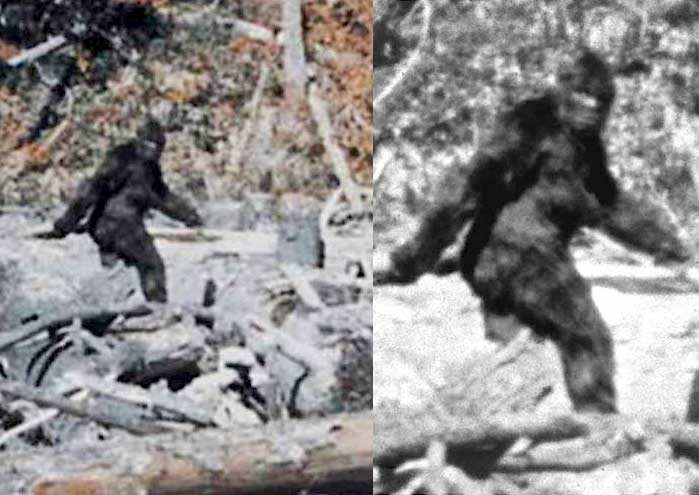
© Patterson-Gimlin/public domainFamous VFC-2 Frame 354 (popularly referred to as 352)
The anthropological sciences occasionally have to deal with something which has a profound but unexpected impact on our understanding of human origins.
Two events are noteworthy, in part because both impacted powerfully upon our concept of human evolution, but also because they were diametric opposites. One was a truth first rejected, and the other was a false contrivance embraced as fact. As presented in Roger Levin's fine text,
Bones of Contention, the stories of the Piltdown Man and the Taung Child were meaningful because they demonstrated that ultimately the evidence will lead to the truth, but first, one must examine that evidence with an impartial and open mind.
Sadly, they also illustrated that confirmation bias is a serious and formidable obstacle in the search for truth. Piltdown was a fraud, an orangutan jaw mated to a human skull, and it confirmed the bias of expecting that our human ancestor would be an ape-like body affixed to a human cranium, thus affirming that regardless of how primitive the body, the illustrious human mind remained robustly beyond any mere ape.
Taung was a truthful hominid fossil, but its rightful place in human origins was rejected for many years because of its small brain. So, when we consider that some evidence with potential impact upon human origins is misunderstood, or suffers in the face of a confirmation bias, the idea has a solid foundation of prior examples demonstrating that exact issue.
Perceptions of "The Bigfoot Film"Today we have a new subject with the potential to make a profound and unexpected impact upon human origins and the human family tree. And like Piltdown and Taung, there is a legitimate concern that the evidence is not being given a proper and impartial evaluation, with confirmation bias ruling the roost and dissuading the scientific community from a proper consideration of that evidence. That new subject is actually 50 years old, but it is the age of the controversy that actually justifies a new way of thinking about it today.
The subject in question is a 16mm motion picture film, taken in the woodlands of Northern California in 1967, famously referred to as the Patterson-Gimlin Film or PGF (in recognition of the two men who were present, one man filming and the other man witnessing the event),
but it is informally known as "The Bigfoot Film" (in recognition of the subject figure seen in that film footage).
For 50 years, people have been denouncing this film footage as a fake, yet there is virtually no rigorous and logically structured proof for that conclusion. All that can be found are insinuations, suggestions, unsubstantiated claims, and intellectual bullying to try and cajole people into accepting the claim of hoax as a fact.
But in fact, the more rigorous the analysis, the more we see inconclusive determinations. David Daegling, in his text,
Bigfoot Exposed analyzed the film and concluded, that at his time of writing, 36 years after the event,
no proof of a hoax could be found. More recently, Authors Donald Prothero and Daniel Loxton, in
Abominable Science could do no better, and their analysis of this film resulted in a meager comparison to an anecdotal bigfoot sighting by a man named William Roe. Their conclusion was that if Roe's anecdotal account could somehow be proven false, then the PGF might reasonably also be deemed a fake. Given that Roe's encounter cannot be proven false, this was a subtle but tacit admission that the PGF cannot be proven false either.
Anecdotal Claims and SuspicionsMost advocates for the film being a hoax tend to rely upon anecdotal claims and suspicions that Roger Patterson was an untrustworthy man, and thus the film must be suspect, if not outright condemned, as equally untrustworthy. But aside from the inherent unreliability of anecdotal material as evidence, one must go further and ask, does this anecdotal material in any way change the empirical evidence? Does it change the film type, the camera type, the image resolution of the film, the filming sequence of events as shown in the film, the potential for stereo-photogrammetry analysis to map the subject walking through the landscape and the camera operator pursuing the subject while filming, or the analysis of the subject figure's body in motion? If anecdotal material does not change any of these empirical subjects of analysis, then the analysis can stand on the empirical data, and the anecdotal material, regardless of how juicy the gossip, can be recognized for what it is, gossip.
There are only two reasonable explanations for why no conclusive proof of a hoax has been produced. One explanation would be to say the evidence is insufficient to make a rigorous conclusion. The other explanation is that the film cannot be proven to be a fake because it is not one. And this second explanation is what the anthropological sciences need to be mindful of, because
if this is in fact the explanation, then a new and significant reconsideration of the hominid family tree is in order, and a new hominid needs to be added to the family. And that would be a major development most anthropologists would dream to accomplish, so their name may go beside Leakey and Johanson in the annals of human origin studies.
So, with this curious film evidence holding a potential to shake up the human family tree and project some scholar to lofty acclaim, why don't we see scholarly candidates eager to explore this evidence and make some kind of determination. Like the disdain and arrogant rejection Raymond Dart experienced when his Taung Child skull was denied its truthful merit for decades, this curious film may also be suffering the same disdain and arrogant rejection.
It deserves better. The following is why:To access the rest of this article, go
here.
Reader Comments